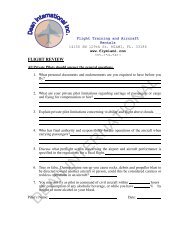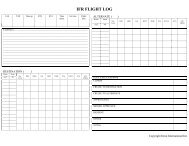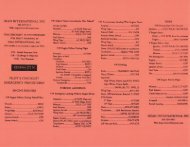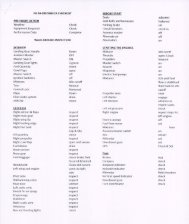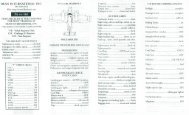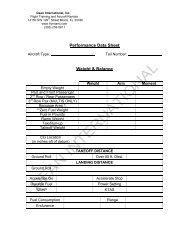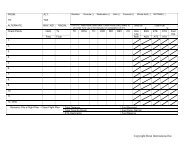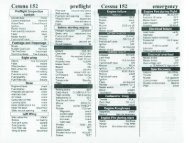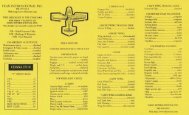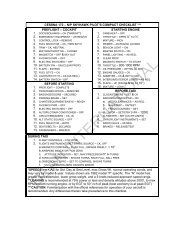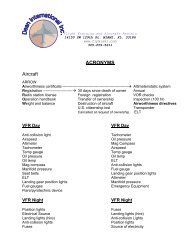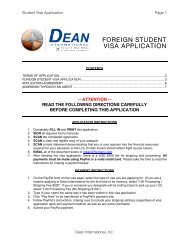Piper PA-28 Arrow Commercial Maneuvers - Dean International
Piper PA-28 Arrow Commercial Maneuvers - Dean International
Piper PA-28 Arrow Commercial Maneuvers - Dean International
You also want an ePaper? Increase the reach of your titles
YUMPU automatically turns print PDFs into web optimized ePapers that Google loves.
<strong>Dean</strong> <strong>International</strong> Inc.<br />
<strong>Commercial</strong> Pilot <strong>Maneuvers</strong><br />
<strong>PA</strong>-<strong>28</strong>-201 <strong>Arrow</strong><br />
Slow Flight<br />
Perform two 90° clearing turns while maintaining altitude.<br />
Complete pre-maneuver check list: Fuel selector proper tank, mixture rich, fuel<br />
pump on, seat belts fastened.<br />
Reduce power to 15° MP and trim off to maintain altitude.<br />
Below 129 knots, extend gear and check for 3 green lights while maintaining<br />
altitude and heading.<br />
Below 103 knots, extend flaps 1 st notch while maintaining altitude and heading,<br />
then proceed to the 2 nd notch while maintaining altitude and heading. Finally<br />
extend the 3 rd notch while maintaining altitude and heading.<br />
Propeller full forward – below 100 kts.<br />
Power to approximately 20”.<br />
Target speed should be 65 to 70 knots.<br />
Control altitude with power and speed with pitch.<br />
To Recover:<br />
Apply full power.<br />
Retract flaps to 10°.<br />
Re tract landing gear and reduce angel of attack as necessary to maintain altitude.<br />
Retract rest of flaps to 10°.<br />
Fuel pump off.<br />
Resume normal cruise.<br />
Power Off Stall<br />
Perform two 90° clearing turns while maintaining altitude.<br />
Complete pre-maneuver check list: Fuel selector proper tank, mixture rich, fuel<br />
pump on, seat belts fastened.<br />
Retract power to 15” MP and trim off to maintain altitude.<br />
Below 129 knots, extend gear and check for 3 green lights while maintaining<br />
altitude and heading.<br />
Below 103 knots, extend flaps 1 st notch while maintaining altitude and heading,<br />
then proceed to the 2 nd notch while maintaining altitude and heading. Finally<br />
extend the 3 rd notch while maintaining altitude and heading.<br />
Propeller full forward - below 100 kts.<br />
Reduce power to idle, gradually increase the angle of attack (maintain right<br />
rudder) until some buffeting occurs.<br />
At the first indication of the stall (First Buffet), recover by lowering the nose<br />
below the horizon and giving maximum power (right rudder) as airspeed<br />
increases.<br />
Establish positive rate of climb, then retract flaps to 10°; landing gear and rest of<br />
flaps (in this sequence).<br />
Fuel pump off.<br />
Establish normal cruise power settings.
Power On Stall (Take-Off and Departure Stall)<br />
Perform two 90° clearing turns while maintaining altitude.<br />
Complete pre-maneuver checklist: Fuel selector proper tank, mixture rich, fuel<br />
pump on, seat belts fastened.<br />
Reduce power to 15” MP and trim off to maintain altitude.<br />
The speed should be gradually reduced to take-off speed (approximately 65 to 70<br />
knots) while maintaining altitude: propeller full forward.<br />
When take-off speed is achieved: add full power, increase the angle of attack<br />
(right rudder) until the stall occurs.<br />
Recover by lowering the nose to the horizon, maintain coordination and then<br />
establish a positive rate of climb.<br />
Fuel pump off.<br />
Return to normal cruise when enough speed is gained.<br />
Steep Turns<br />
Perform two 90° clearing turns while maintaining altitude.<br />
Power to 22” RPM 2400.<br />
Complete the pre-maneuver checklist: Fuel selector proper tank, mixture rich, fuel<br />
pump on, seat belts fastened.<br />
Smoothly roll into 50° of bank while maintaining altitude and coordination. Roll<br />
out approximately 25° before desired heading. Upon completion of one 360 go<br />
right away into the next 360 on the other side.<br />
It is important to maintain altitude exactly, hold a constant bank during the turn<br />
and roll out on exactly the same heading as you rolled in. Use outside references.<br />
Chandelle<br />
Perform two 90° clearing turns while maintaining altitude.<br />
Complete the pre-maneuver checklist: Fuel selector proper tank, mixture rich, fuel<br />
pump on, seat belts fastened.<br />
Establish 2 reference points (90° and 180°)<br />
Start the maneuver by rolling into a 30 bank gradually increase the angle of<br />
attack, the props forward and add full power (maintain coordination).<br />
When the 90° reference point is reached hold the pitch constant and gradually roll<br />
out only after passing the 90° point so that 180° point is reached with the wings<br />
level; hold this altitude momentarily, then release the pressure on the elevator so<br />
the airplane returns to cruise flight . Reduce power settings to normal cruise.<br />
Note: First half of the maneuver should be: constant bank (no greater than 30°) and<br />
changing pitch. Be careful not to over bank. Second half should be: constant pitch,<br />
changing bank, (Roll Out) speed to finish should be 5 to 10 knots above stall.<br />
Lazy Eight<br />
Perform two 90° clearing turns while maintaining altitude.<br />
Mixture normal, prop 2300 RPM, throttle 22” MP.<br />
Enter at Va.<br />
Perform Lazy Eight as described in Operating Procedures for Cessna 172.<br />
Power should be adjusted slightly for conditions to maintain an average altitude.
Eight on Pylons<br />
Before starting this maneuver calculate the pivotal altitude applicable for the <strong>PA</strong><br />
<strong>28</strong>-201 and show how it is accomplished –KTAS squared divided by 11.5 knots<br />
or 15 mph.<br />
Perform two 90° clearing turns while maintaining altitude.<br />
Complete pre-maneuver checklist: Fuel selector proper tank, mixture rich, fuel<br />
pump on, seat belts fastened.<br />
Determine wind direction and select 2 pylons which are located perpendicular to<br />
the wind.<br />
Select the appropriate pivotal altitude depending on the aircraft true airspeed.<br />
Start the maneuver by flying downwind between the pylons at 45° angle of entry.<br />
Reach to the first pylon and roll into a coordinated medium to steep bank so the<br />
airplanes, lateral axis pivots on the pylons.<br />
Since the airplane is turning around the pylon there will be a point where it is<br />
going to face the wind (upwind side of the maneuver). At this point, the ground<br />
speed is going to decrease which is evident by observing the pylon moving ahead<br />
of the reference point on the airplane: this needs to be corrected by lowering the<br />
nose and decreasing bank and for instance, building up more speed to “catch” the<br />
pylon.<br />
When the airplane is located between the pylons at 45° angle, the other pylon<br />
should be the target by flying momentarily straight and level until the airplane is<br />
exactly abeam.<br />
Since the increasing so the pylon appears to be moving behind the airplane; this<br />
needs to be corrected by increasing the angle of attack and increasing bank to<br />
decrease ground speed, so the pylon “catches” the airplane.




